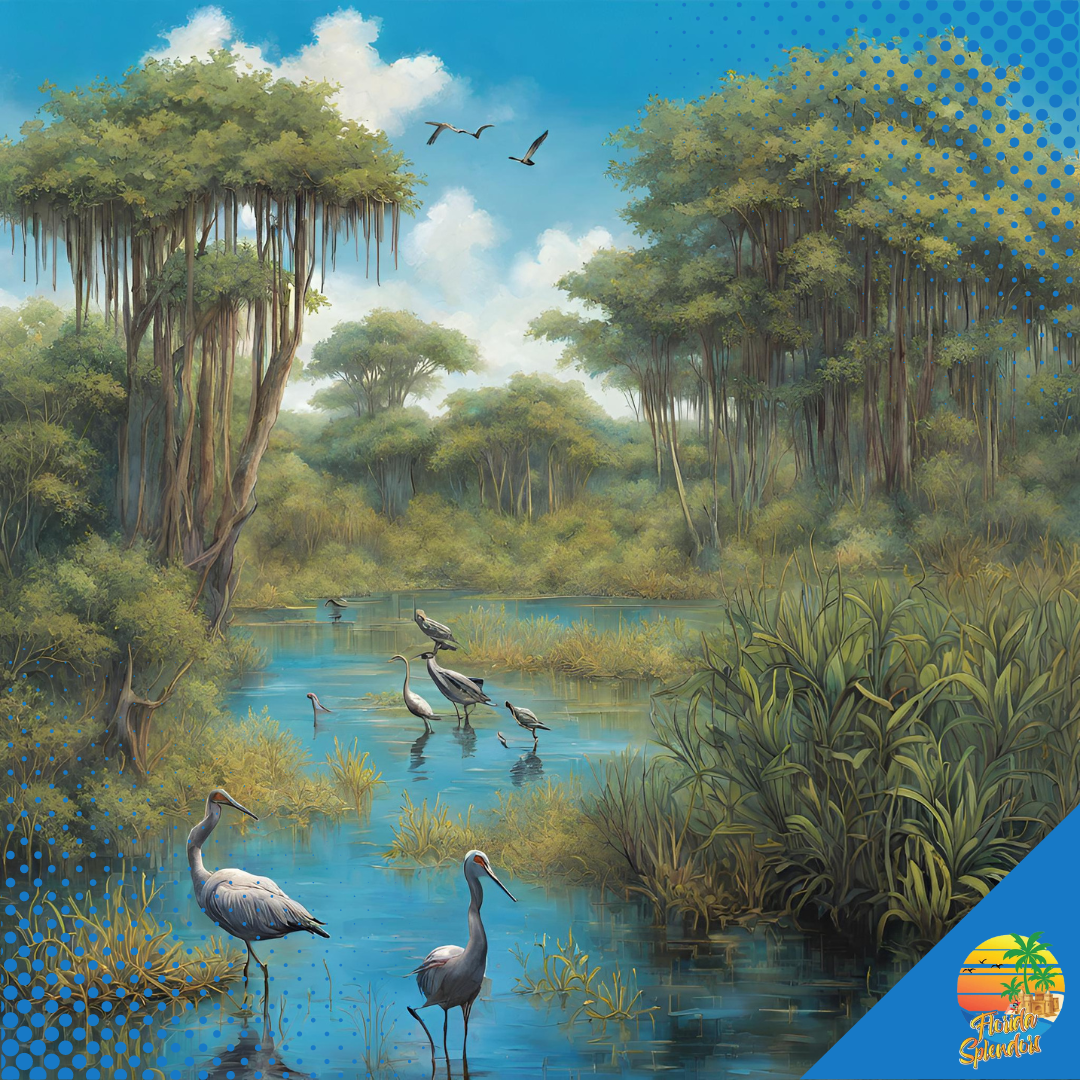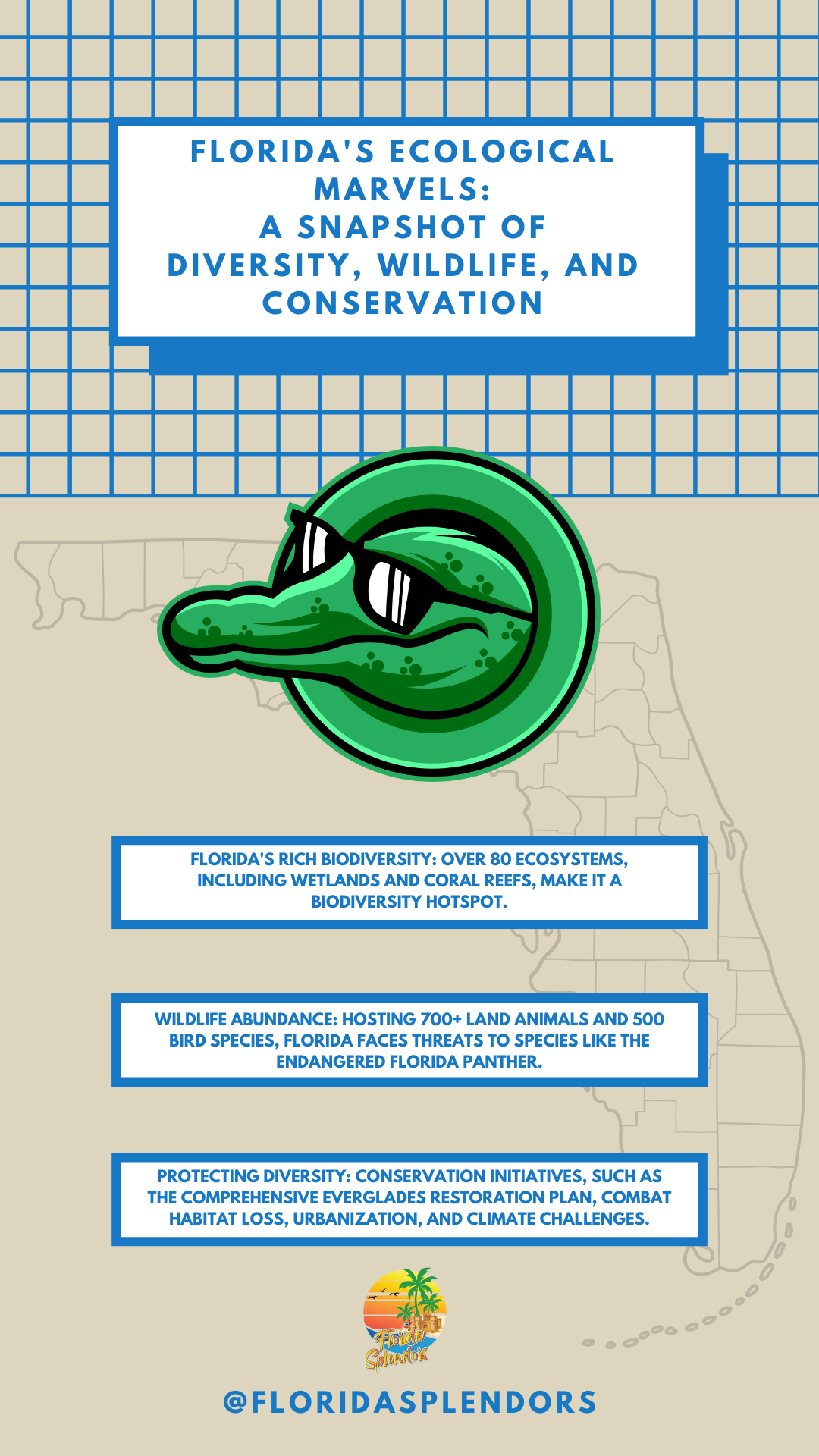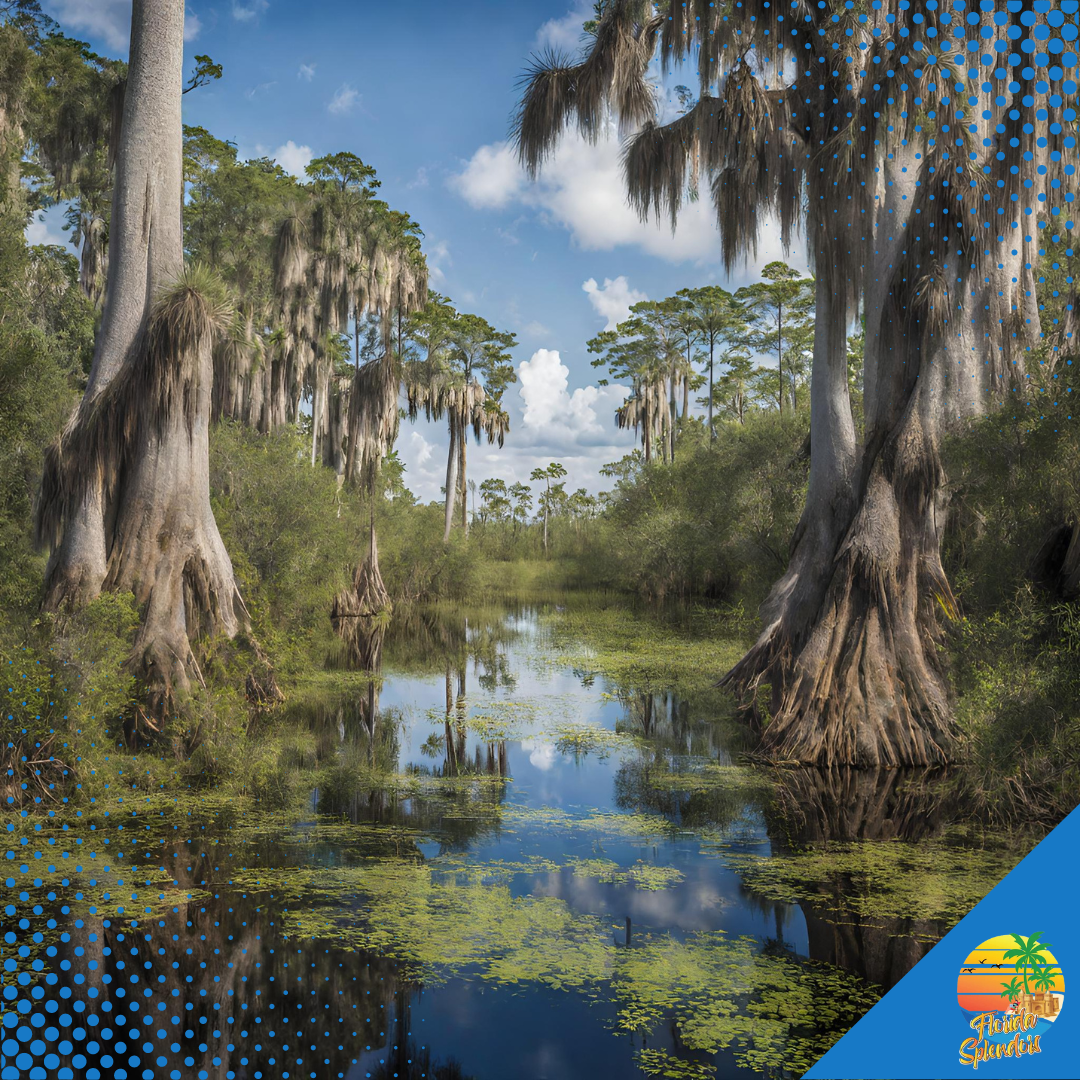==================
Florida Splendors is supported by our audience. When you purchase through one of our links, we may earn a small affiliate commission. As an Amazon Associate I earn from qualifying purchases. Your cost is not affected.
Nestled under the warm embrace of the Florida sun lies a tapestry of ecosystems as diverse as they are vital. With over 80 unique habitats, from the iconic Everglades to the sandy shores of its beaches, Florida stands as a geographical masterpiece shaped by the intricate dance of hydrology, climate, and biodiversity.
In this article, we embark on a journey through the Sunshine State’s natural wonders, exploring the rich wildlife, endangered species, and the delicate balance between human interaction and conservation efforts that define the intricate web of life in Florida’s ecosystems.
Join us in unraveling the vibrant mosaic that makes Florida a global biodiversity hotspot, where every habitat plays a crucial role in preserving the state’s natural heritage.
Ecosystems in Florida: Unveiling the Diversity and Vitality of Sunshine State’s Ecological Marvels
The ecosystems in Florida are as diverse as they are vital, supporting an array of unique species and landscapes. From wetlands to coral reefs, this article explores the intricate web of life these ecosystems support. Discover the roles these habitats play and understand the environmental challenges they face, providing a glimpse into the importance of Florida’s natural mosaic ahead.

Key Takeaways
- Florida hosts over 80 unique ecosystems, such as wetlands, coastal dunes, coral reefs, and pine flatwoods, contributing to its status as a biodiversity hotspot with a wide range of plant and animal species.
- The rich wildlife and assorted plant species in Florida’s ecosystems face threats from human activities, such as urbanization, that lead to habitat loss and endangerment of species like the Florida panther and manatee.
- Conservation efforts, like the Comprehensive Everglades Restoration Plan and water resource management, are vital for supporting the diverse ecosystems against challenges posed by human interaction, urban development, and climate change.

Ecosystems in Florida: Delving into the Varied Tapestry of Sunshine State’s Natural Wonders

Florida, the land of perpetual sunshine, is home to over 80 unique ecosystems, each meticulously sculpted by the intricate interplay of hydrology, climate, landforms, and biotic factors like flora and fauna. This geographical masterpiece, caressed by the Gulf of Mexico, Florida Bay, and the Atlantic Ocean, thrives under a climate that oscillates from humid subtropical in northern Florida to tropical in the south, creating a dynamic symphony of ecological variations. Some of the diverse Florida’s ecosystems found in the state include:
- Wetlands, such as the Everglades and the Big Cypress Swamp
- Coastal dunes and Florida’s beaches
- Pine flatwoods
- Hardwood hammocks
- Cypress swamps
- Salt marshes
- Coral reefs
- Mangrove forests
These ecosystems provide habitat for a wide range of plant and animal species, making Florida a biodiversity hotspot.
Florida’s landscape is a treasure trove of unique habitats, from the scrub ecosystems of the Lake Wales Ridge to the coral reefs of the Florida Keys. These habitats don’t just add aesthetic beauty to the landscape but also contribute to Florida’s reputation as a globally recognized biodiversity hotspot. A detailed exploration of specific habitats such as coastal systems, inland wetlands, and forested regions is essential to fully grasp the diversity of Florida’s ecosystems.
Coastal Systems and Beaches
Florida’s coastal systems, including mangrove forests and beaches, are the unsung heroes of the state’s ecological narrative. Mangroves, with their unique salt-tolerance mechanisms and aerial root systems, flourish in saline and anaerobic conditions along coastlines, stabilizing shorelines, filtering pollutants, and nurturing a diverse range of marine life.
The state’s beaches and sand dunes serve as nesting grounds for sea turtles and are protected by coral reefs, which mitigate erosion and shield coastal habitats from storm damage. Nonetheless, the threats posed by stormwater discharges, imminent urbanization, and sea-level rise jeopardize these coastal systems.

Inland Wetlands and Lakes
Stepping away from the coastal regions, we find another vital facet of Florida’s ecosystems – the inland wetlands and lakes. These habitats, encompassing:
- marshes
- swamps
- bogs
The famed Everglades serve key ecological functions including water purification, flood control, and providing habitat for wildlife. The state’s lakes, ranging from small ponds to large bodies of water like Lake Okeechobee, are integral to water storage and home to an array of aquatic species.
Keystone species, such as the American alligator, create essential habitats within wetlands, benefiting a plethora of species. Threats to these wetlands and lakes, such as diminished groundwater recharge, swamp drainage, and pollution, compromise the natural water storage and water quality.
Forested Regions and Pine Flatwoods
Emerging from the wetlands, we enter the pine forests of Florida, characterized by pine flatwoods ecosystems that cover most of the state. These ecosystems feature a complex, three-layered vegetation structure of herbaceous forbs, shrubby hardwoods, and a canopy of species like slash pine, longleaf pine, and pond pine.
Wildflowers such as Michaux’s milkweed, hairy trilisa, and goldenaster add to the botanical diversity found within pine flatwoods, which are maintained by frequent fires that clear out growth congestion and aid plant and animal reproduction.
The Ocala National Forest, with its expansive pine flatwoods, serves as a key area for ecosystem health and species protection.

The Fauna of Florida: A Wildlife Haven

On this journey through Florida’s ecosystems, one cannot overlook the rich tapestry of wildlife that calls these habitats home. With over 700 species of land animals, Florida is a veritable wildlife haven. The state’s aviary population is highlighted by more than 500 species of birds, including:
- an estimated 1,500 nesting pairs of bald eagles
- the colorful roseate spoonbill
- the majestic great blue heron
- the endangered Florida scrub-jay
Migratory water birds use Florida as a crucial stepping stone before reaching island destinations such as Cuba, Hispaniola, and Puerto Rico. However, the delicate balance of this wildlife haven is threatened by human activities, as demonstrated by the critically endangered Florida panther, whose survival is severely threatened by vehicle collisions.
Endangered Species and Conservation Efforts
Florida’s wildlife is not immune to the global threat of species endangerment. The state is home to a variety of endangered species, including:
- Florida panther
- Leatherback sea turtle
- West Indian manatee
- Red-cockaded woodpecker
The Florida panther, the state’s official animal, is critically endangered, with fewer than 100 individuals remaining in the wild. It’s a stark reminder of the fragility of wildlife in the face of human encroachment and habitat loss, and testament to the urgent need for conservation efforts.
Dominant Species and Their Roles
As concerning as the plight of endangered species is, acknowledging the vital roles of dominant species within ecosystems is equally critical. Like the cypress trees in swamps and various oaks in upland communities, these species support the life cycles of other animals.
One notable example is the American alligator, which creates wet areas during the dry season that benefit many species and offer protection for nesting birds from predators. These dominant species are the ecological linchpins that hold the diverse ecosystems of Florida together.
Plant Life Across Florida’s Biomes

The flora of Florida is as diverse as its fauna, with over 2,800 native species dotting the landscape. These plants, including cypress trees and Sabal palms, are adept at surviving Florida’s fluctuating wet and dry seasons, although non-native plants often require additional irrigation.
Seagrass beds, for instance, are critical to marine life, aiding in maintaining water clarity and contributing to carbon sequestration. The use of Florida-Friendly landscaping strategies that prioritize native plants can minimize the need for supplemental water and contribute to the preservation of clean waterways.
Adaptive Flora in Extreme Conditions
Certain plant species in Florida have developed adaptive strategies to survive in environments with reduced water availability. For instance, mulching in gardens can reduce the amount of water needed by up to 50 percent, assisting plant species in adapting to these environments.
These adaptations highlight the resilience and tenacity of Florida’s flora, which have evolved to thrive in the state’s diverse ecosystems, from the salty coastal regions to the drier inland areas, all documented by the central florida press.
Water’s Influence on Florida’s Natural Communities

Water plays a significant role in shaping Florida’s natural communities. However, human activities and climate change have disrupted water systems, leading to impacts on ecosystems. The redesign of natural waterways, especially the redirection from Lake Okeechobee to Florida Bay, has disrupted the Everglades and coastal ecosystems due to development in South Florida.
Alteration of water flow, combined with pollution from pesticides, fertilizers, and chemicals, has led to imbalances and contamination of water systems vital to Florida’s natural environments. This section investigates the importance of clean water for sustaining habitats and the influence of climate change on water resources.
The Role of Clean Water in Sustaining Habitats
Clean water is indispensable in supporting the diverse springs, rivers, lakes, and wetlands in Florida. However, the depletion of aquifers and surface waters due to overuse for irrigation, industry, and public supply has led to reduced flow of springs and rivers, affecting the state’s aquatic ecosystems.
Efforts such as the restoration of Lake Okeechobee’s natural hydrology are in progress to counteract the impact of water pollution and mismanagement. Florida has implemented landscape irrigation restrictions and promoted the use of reclaimed water as part of their water conservation measures, resulting in significant reductions in water usage.
Climate Change and Its Effects on Water Resources
Climate change also significantly influences Florida’s water resources. The state is experiencing major climatic shifts including:
- Sea level rise
- Changes in precipitation
- Changes in air temperature
- Extreme events
- Increased carbon dioxide (CO2) concentrations.
Wetland-dependent species and ecosystems, such as the Everglades, anticipate habitat loss and degradation resulting from climate-induced alterations in precipitation, temperature, and sea level. The projected urban expansion and sea level rise pose a significant threat to Florida’s conservation efforts in ecosystems such as High Pine, Coastal Uplands, and Freshwater Aquatics.
Human Interaction with Florida’s Natural Landscape

Human interaction with Florida’s natural landscape has had profound implications for its ecosystems. Land conversions for agriculture and urban development have significantly altered Florida’s landscape, impacting its natural ecosystems.
Developing lands and man-made structures have brought certain species, like the Florida panther, to an endangered status by destroying their habitats and diminishing hunting grounds. This section covers the equilibrium between development and conservation as well as current restoration and recovery initiatives.
The Balance Between Development and Conservation
Striking a balance between development and conservation is crucial for preserving Florida’s biodiversity and ecosystem functions. For instance, the gopher tortoise, an inhabitant of open sandy upland grasslands and ridges in Florida, is encountering habitat loss due to expansive development and the intrusion of invasive plant species.
Urban development in Florida’s natural landscapes is causing a decrease in biodiversity and the deterioration of ecosystem functions. However, adopting sprawl reduction techniques in urban planning could help in lessening the detrimental effects on conservation areas compared to current urbanization trends.
Restoration and Recovery Programs
Restoration and recovery initiatives are essential in counteracting the adverse effects of human activities on Florida’s ecosystems. The Comprehensive Everglades Restoration Plan (CERP), for instance, aims to improve water quality and natural water flow, marking a cornerstone in Florida’s efforts to restore and maintain the health of its ecosystems.
The restoration of the Kissimmee River, one of the largest successful ecosystem restoration projects globally, transformed a previously channelized river back into its meandering natural state. These efforts, coupled with the state’s commitment to expedite Everglades projects and emphasize the protection of Florida’s natural resources, underscore the significance of restoration and recovery programs in preserving Florida’s natural landscapes.
Summary
In the journey through Florida’s diverse ecosystems, we’ve explored the varied habitats from coastal systems to inland wetlands, and from forested regions to pine flatwoods. We’ve marveled at the rich fauna, the dominant species, and the endangered ones fighting for survival. We’ve admired the adaptive flora that adds color and life to these landscapes.

We’ve also seen the significant role that water plays in shaping these natural communities and the challenges posed by human activities and climate change. But amidst these challenges, there is hope. From the balance between development and conservation to restoration and recovery programs, efforts are underway to preserve these natural wonders for generations to come.
Frequently Asked Questions
What's Inside
What is the main ecosystem in Florida?
The main ecosystem in Florida consists of savannas, grasslands, deciduous forests, and the unique Florida Everglades, which contain all three of these biomes. Additionally, the marine biome plays a significant role, given Florida’s coastal location.
What are the 7 main types of ecosystems?
The seven main types of ecosystems are terrestrial, forest, grassland, desert, tundra, aquatic, and freshwater/marine ecosystems.
What is Florida's biome?
Florida’s main biomes are temperate deciduous forest and tropical grassland, with a significant presence of wetland biomes.
What are some of the unique ecosystems in Florida?
Florida boasts over 80 unique ecosystems, such as mangrove forests, beaches, wetlands, lakes, and pine flatwoods.
What are some of the dominant species in Florida and what role do they play in the ecosystem?
The American alligator and various oak species are dominant in Florida and play crucial roles in supporting other animals in their ecosystems.
Dive into Sunshine State Marvels: Connect with Florida Splendors!
Unlock the secrets of Florida’s allure! Follow the adventure on Facebook, catch the vibes on Instagram, pin your favorites on Pinterest, and tweet along on Twitter. Join a vibrant community celebrating Florida’s wonders—where every moment is an invitation to explore!
#DiscoverFlorida #FloridaSplendors


I’ve been following your blog for quite some time now, and I’m continually impressed by the quality of your content. Your ability to blend information with entertainment is truly commendable.